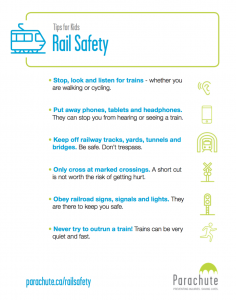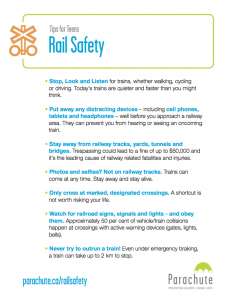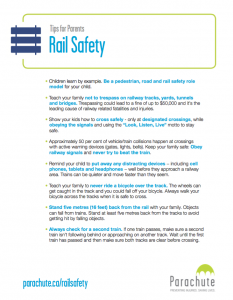There are 44,917 kilometres of railway tracks and 23,000 public and private crossings in Canada. Trains today are quieter than ever and cannot stop easily, once moving.
Safety tips around railway tracks
Cross at the right place and time.
Only cross at designated crossings at railway tracks. Don’t take shortcuts or try to cross the tracks when the flashing lights have come on and the gate is down.
Obey the signals.
Never walk around a closed gate. At designated crossings, light signals start flashing and gates start closing only 20 seconds before the train reaches the crossing. This is not enough time to cross the track.
Don’t trespass.
Railway property is private property. Stay off rail tracks and out of railway yards, tunnels and bridges. Don’t use tracks as a walking path or as the backdrop for photos. Trespassing can result in a fine and is the leading cause of railway related fatalities and injuries.
Make sure the way is clear.
If you must cross railway tracks, stop, look and listen before crossing.
A train can’t stop as quickly as a car.
A train needs much more time and space to come to a complete stop than a car does. Even under emergency braking, a train can take up to two kilometres to come to a complete stop. Unlike a car, a train cannot swerve to avoid a collision.
Never try to outrun a train.
Trains are closer and moving faster than you realize. The average 150-car freight train is travelling at 100 km/h.
Stand five metres (16 feet) back from the rail.
Objects can fall from trains. Stand at least five metres back from the tracks to avoid getting hit by falling objects.
Check for a second train.
If one train passes, make sure a second train isn’t following behind or approaching on another track. Wait until the first train has passed and then make sure both tracks are clear before crossing.
Never ride a bicycle over train tracks.
The wheels can get caught in the track and you could fall off your bicycle. Always walk your bicycle across the tracks when it is safe to cross.


